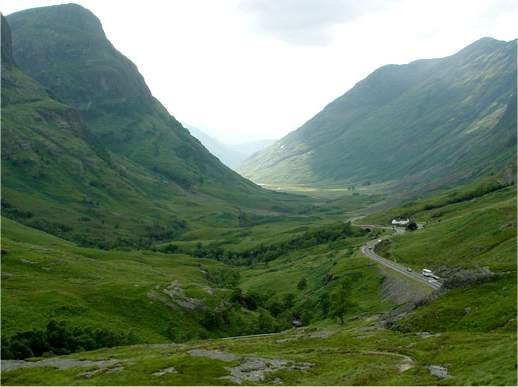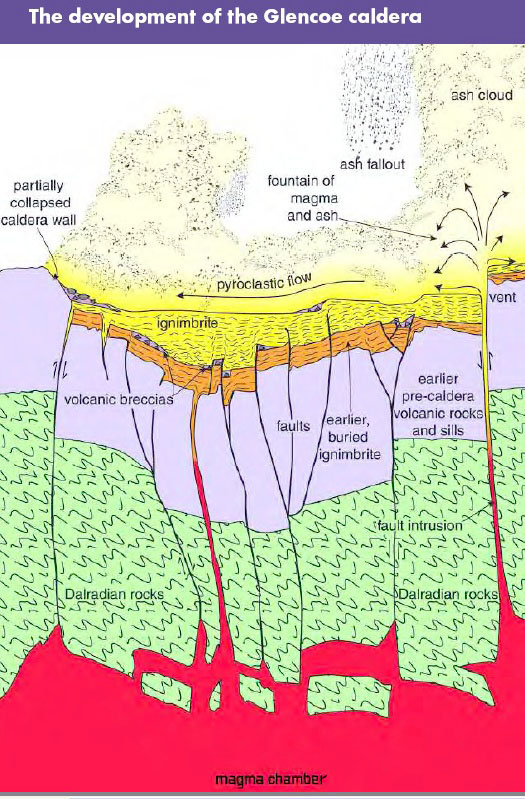Glencoe EarthCache
-
Difficulty:
-

-
Terrain:
-

Size:  (other)
(other)
Please note Use of geocaching.com services is subject to the terms and conditions
in our disclaimer.
Glen Coe is probably Scotland’s most famous and most scenic Highland glen. Visitors from all over the world flock here year after year, inspired by the sheer scale and grandeur of its surrounding mountains and fascinated by the intrigue of its turbulent past.
But how did such a beautiful landscape rise?

The rocks at Glencoe, including the volcanic rocks, bear witness to many different environments: some were formed on the floor of a shallow sea, others in subtropical deserts, and some were ground down under the base of a vast ice sheet.
Around 470-460 million years ago a period of extraordinary upheaval and violent movement changed the face of the Earth and initiated the process of mountain building that we recognise in the geology of today’s landscape. This was the period of Caledonian mountain building, when the huge geological plates carrying the ancient continents of Laurentia, Baltica and Avalonia collided.
Then 420 million years ago Glencoe witnessed a period of cataclysmic volcanic activity. During this time five major volcanic eruptions occurred, each of which displaced thousands of cubic kilometres of magma from inside the Glencoe volcano, leaving a huge void. After each eruption the unsupported rocks sagged and collapsed piecemeal along the major fault lines into the magma chamber below, forming a ‘caldera’, a huge basin-like crater, eventually extending to some eight kilometres across.
Calderas can be many tens of kilometres across and hundreds of metres deep; they should not be confused with volcanic craters, which are smaller features formed at the site of eruptions. The inner walls of a caldera are steep and unstable; they frequently collapse to add huge pilles of volcanic debris to the caldera floor.

Ash fall-out and ash flows were not the only products of the caldera eruptions. In some eruptions, fountains of magma close to the vent released much of the trapped gas, so that when the hot, still fluid blobs fell to the ground they coalsced and flowed more like lava.
The violent caldera eruptions all involved relatively silica-rich magma. Some of the late eruptions were of less silica-rich, andesitic magma, which was more fluid and contained less gas. So we can find here some unusually thick shetts of andesite, with spectacular cooling joints that form columns up to two hundred meters high?

Later in the history of Glencoe, after much of the volcanic activity had ceased, magma was squeezed into the fault lines, were it solidified to form the so-called ring intrusions that now surround the volcanic rocks.
Over the millions of years since the caldera formed, hundreds of meters of volcanic rock have been eroded by ice, wind and rain; what we see today is the exposed remnants of ancient volcanic eruptions that sunk into the caldera millions of years ago.
The Glencoe volcano could have been active for up to five millon years, but that was not the end of the story, for magma continued to be injected into the crust troughout the Glen Coe area for another ten millions years
Taken from materials: The National Trust for Scotland, British Geological Survey - Ben Nevis and Glencoe: A landscape fashioned by geology.
To claim this cache you must send answers to the following questions to my profile GOGO CZ.
a) What is altitude at the starting position (leads co-ordinates)?
b) What is the name of the period when Glencoe was ‘built’?
c) Near the starting position was an information table. Now it is missing but you will manage the answer without it. What is the common name of the three hills in front of you?
Optional task: Insert your photo taken from the leads co-ordinates with south hills in the background to your log.
You would add to the value of the site.
You can log the cache without my confirmation but you should send me answers before. If there is anything wrong with your answers I will let you know. Logs without sending answers will be deleted.

Additional Hints
(No hints available.)